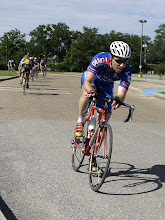Simple physiology
"I want to ride faster." That seems like the most common goal of the performance oriented cyclists that I work with. I think this is a great goal. There are a host of reasons to ride a bike. Riding fast is just one of them. For me, riding fast is superseded by the sense of being free. There's some sort of connection between my last ride and the first time I ever rode a bike. It's something subconscious but it's there.
As a coach, I always want to help clients ride faster. There is a multifaceted approach that includes physiologic and biodynamic development. The intent of this post is to share a brief overview of physiology.
Here's the statement: If you intend to ride faster for durations longer than 60-90 minutes, you are forced to develop your aerobic energy systems. You really don't have many options here. We are all bound by the physiology that keeps us ticking.
Aerobic energy sources derive a large portion of their energy resources from fat. You have days to weeks worth of fat energy stored within your body. Optimizing the utilization of this energy source developing the proper infrastructure so that larger and larger amount of oxygen are available during the metabolic processes is the goal. Simply said, to ride faster and longer, you have to be able to produce enough ATP(energy) through aerobic metabolism to sustain your pace. If you can't provide the adequate ATP for the intensity you are riding, begins the shift toward anaerobic metabolism which has significant temporal limitations.
Anaerobic metabolism is fed by sugars. For the most part, these sugars are stored in the body as reserve fuel. There's only a limited amount of metabolic potential in stored sugars compared to fat. In fact, there's only about 60-90 minutes worth when you are heavily depending on it. Yes, the body can convert fat and protein to sugar but it can't do this at a rate which is fast enough to supply the required needs. With anaerobic metabolism, you are also limited by your ability to manage lactate or commonly referred to as lactic acid. Lactate is a byproduct of anaerobic metabolism. It changes the pH in the cell and disrupts muscular contraction at higher concentrations. So, it should be noted that anaerobic metabolism allows for faster speeds because it gives us the ability to produce large amounts of ATP, however, there are temporal and biochemical limitations. Neither of these are seen with aerobic metabolism.
I have to move on to other things. More later.


0 Comments:
Post a Comment
<< Home